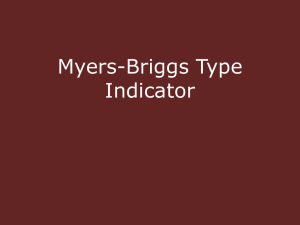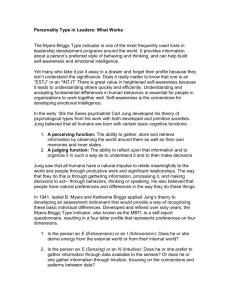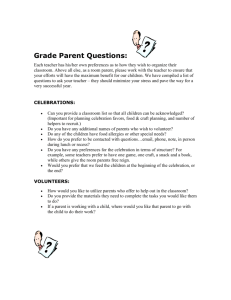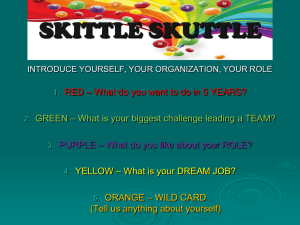myers-briggs type indicator
advertisement
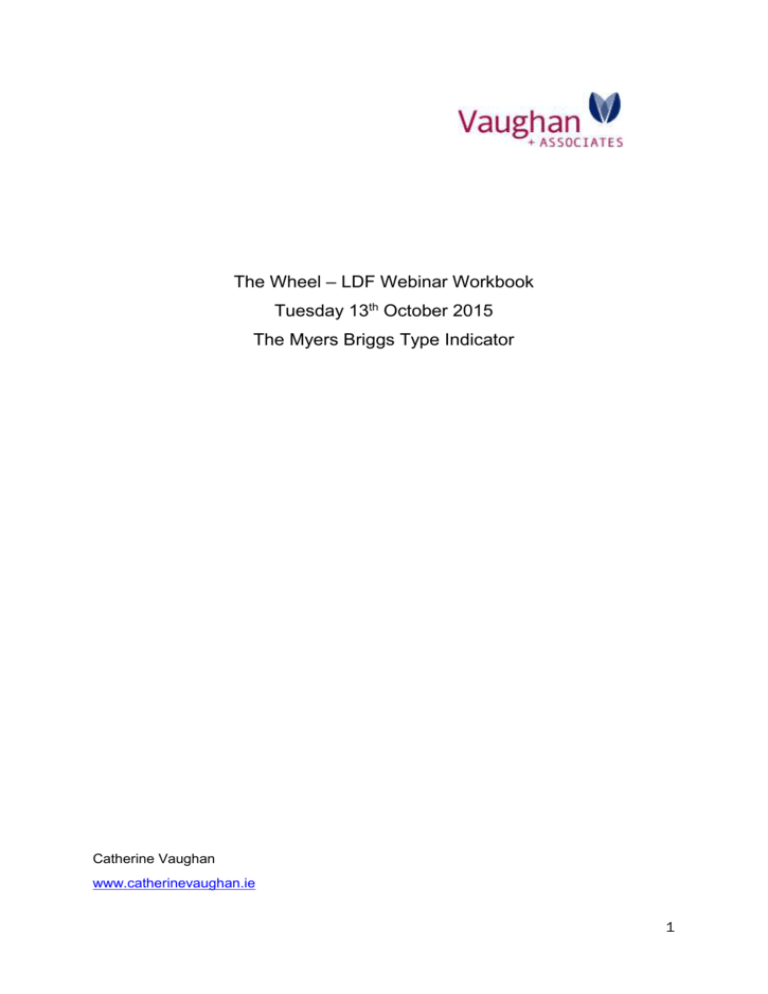
The Wheel – LDF Webinar Workbook Tuesday 13th October 2015 The Myers Briggs Type Indicator Catherine Vaughan www.catherinevaughan.ie 1 MYERS-BRIGGS TYPE INDICATOR The purpose of Myers-Briggs Type Indicator (MBTI) is to make the theory of psychological types described by C.G. Jung (1921/1971) understandable and useful in people’s lives. The essence of the theory is that much seemingly random variation in behaviour is actually quite orderly and consistent, being due to basic differences in how people prefer to use their perception and judgment. Perception involves the ways of becoming aware of things, people, happenings, or ideas. Judgment involves all the ways of coming to conclusions about what has been perceived. If people differ systematically in what they perceive and in how they reach conclusions, then it is only reasonable for them to differ correspondingly in their interests, reactions, values, motivations, and skills. The MBTI has been in development since 1942. The work was begun by Katharine Briggs and was built upon and extended by her daughter Isabel Briggs Myers. They addressed two main goals through their work: 1. The identification of basic preferences on each of the four dichotomies specified or implicit in Jung’s work. 2. The identification and description of the 16 distinctive personality types that result from interactions among preferences. A type is not created by simply adding the 4 preferred ways of functioning. Each type described is greater than the sum of its parts because of the interaction between the four preferences that make up a type. 2 DIFFERENCES BETWEEN THE MBTI AND OTHER INSTRUMENTS The MBTI differs from most personality instruments in that the theory postulates dichotomies. These dichotomies are believed to reflect innate psychological or mental dispositions. The requirement that the instrument reflect these dichotomies has been a major factor in the design of items, use of numerical information to determine type preferences, general psychometric properties, and interpretation of results of the MBTI. The instruments’ most distinguishing features are: It seeks to identify a respondent’s status on one of two opposite personality categories. Most other instruments measure variation along a continuum. MBTI preference indexes indicate how clearly a person prefers one of two opposites. The scores therefore reflect how confident the respondent is in their stated preference. It does not indicate how much of that pole he/she has. A “Trait” instrument would seek to quantify how much of a trait a person has. The self report part of the inventory is crucial to finding type. The individual respondent is viewed as the expert who is best qualified to judge the accuracy of the type descriptions that result from their self report. There are specific dynamic relationships between the four preferences. This leads to the 16 personality types. The type descriptions are designed to reflect a theory that includes a model of development that continues throughout the life span. For example, the theory predicts that younger persons are generally less clear and consistent in their preferences than are mature individuals. As a result we can expect lower reliability coefficients when testing groups of young people and higher reliabilities with older subjects. 3 The MBTI dichotomies are concerned with basic attitudes and mental functions that enter into almost every aspect of behaviour; therefore the scope of practical applications is broad rather than narrow. 4 THE FOUR PREFERENCES THAT MAKE UP TYPE Extraversion (E) - Introversion (I) Attitude or orientation of energy Sensing (S) - Intuition (N) Functions or processes of perception Thinking (T) - Feeling (F) Functions or processes of judging Judging (J) - Perceiving (P) Attitude or orientation towards dealing with the outside world An individual is assumed to have a preference for one of each pair of opposites over the other. The four preferences direct the characteristic use of perception and judgment by an individual. The particular preferences that interact in a person affect not only what is attended to in any given situation but also how conclusions are drawn about what has been perceived. A persons TYPE will be recorded as the letters which indicate each of their preferences e.g. ESTJ or INFP etc. THE HIERARCHY OF TYPE Each type has a dominant function (one of the middle two dichotomies and the 1st or “Commander in Chief”!). Their dominant function will be carried out in their preferred attitude of energy e.g. Extraverted or Introverted. They will then have an auxiliary function (2nd in command) which will be done in their nonpreferred attitude of energy – Extraverted or Introverted. Their tertiary function (3rd) is the opposite of their auxiliary function, done in the same attitude of energy as their auxiliary function. Their inferior function is the opposite of their dominant function, done in the opposite attitude. It is in understanding the dynamics of type that the richness of the MBTI comes to life. It can help to deepen understanding of why each individual operates the way they do, explain differences between people with different types and ultimately create the possibility of deeper understanding between people. 5 UNDERSTANDING THE MYERS BRIGGS TYPES THE E-I DICHOTOMY WHERE DO YOU PREFER TO FOCUS YOUR ATTENTION? WHERE DO YOU GET YOUR ENERGY? EXTRAVERSION (E) INTROVERSION (I) …like to focus on the outer world of people and activity. They direct their energy and attention outwards and receive energy from interacting with people and from taking action. ….like to focus on their own inner world of ideas and experiences. They direct their energy and attention inwards and receive energy from reflecting on their thoughts, memories and feelings. Characteristics associated with people who prefer Extraversion: Characteristics associated with people who prefer Introversion: Attuned to the external environment Prefer to communicate by talking Work out ideas by talking them through Learn best through doing and discussing Have broad interests Sociable and expressive Readily take initiative in work and relationships Drawn to their the inner world Prefer to communicate in writing Work out ideas by reflecting on them Learn best by reflection, mental “practice” Focus in depth on their interests Private and contained Take initiative when the situation or issue is very important to them Which preference describes how you are most clearly? Place an X on the line below. E -------------------------------------------------------------------------------------------------------------------- I 6 THE S-N DICHOTOMY HOW DO YOU PREFER TO TAKE IN INFORMATION? SENSING (S) ….like to take in information that is real and tangible – what is actually happening. They are observant about the details of what is going on around them and are especially attuned to practical realities. Characteristics associated with people who prefer Sensing: Oriented to current realities Factual and concrete Focus on what is real and actual Observe and remember details Build carefully and thoroughly towards conclusions Understand ideas and theories through practical applications Trust experience INTUITION (N) …like to take information in by seeing the big picture, focusing on the relationships and connections between facts. They want to grasp patterns and are especially attuned to seeing new possibilities. Characteristics associated with people who prefer Intuition: Oriented to future possibilities Focus on patterns and meanings in data Remember details when they relate to a pattern Conclude quickly and follow hunches Clarify ideas and theories before putting them into action Imaginative and verbally creative Trust inspiration Which set of descriptions most closely describes how you prefer to operate? Place an x on the line. S------------------------------------------------------------------------------------------------------------------ N 7 THE T-F DICHOTOMY How do you make decisions? THINKING (T) FEELING (F) ……people who prefer to use thinking in decision making like to look at the logical consequences of a choice or action. They want to remove themselves mentally from the situation to view the pros and cons objectively. They are energised by evaluating and analysing to identify a course of action. Their goal is to find a standard or principle that will apply in all similar situations. …..people who prefer to use feeling in decision making like to consider what is important to them and to others involved. They mentally place themselves into the situation to identify with everyone so that they can make decisions based on their values about showing respect for people. They are energised by appreciating and supporting others and look for qualities to praise. Their goal is to create harmony and treat each person as a unique individual. Characteristics associated with people with a Thinking preference: Characteristics associated with people with a Feeling preference: Analytical Empathetic Use cause and effect reasoning Guided by personal values Solve problems with logic Assess impacts of decisions on people Strive for objective standard of truth Strive for harmony Reasonable Compassionate Can appear “tough-minded” May appear “tender-hearted” Fair – want to treat everyone equally Fair – want everyone treated as an individual Which list most closely describes how you make decisions? Place an x on the line. T----------------------------------------------------------------------------------------------------------------------- F 8 THE J-P DICHOTOMY HOW DO YOU DEAL WITH THE OUTSIDE WORLD? JUDGING PERCEIVING …….people who prefer to use their Judging process in the outer world like to live in a planned, orderly way, seeking to regulate and manage their lives. They want to make decisions, come to closure and move on. Their lives tend to be structured and organised, they like to have things settled. Sticking to a plan and schedule is very important to them, and they are energised by getting things done. …..people who prefer to use their Perceiving process in the outer world like to live in a flexible, spontaneous way, seeking to experience and understand life, rather than to control it. Detailed plans and final decisions feel confining to them; they prefer to stay open to new information and last minute options. They are energised by their resourcefulness in adapting to the demands of the moment. Characteristics associated with people who prefer Judging: Characteristics associated with people who prefer Perceiving: Scheduled Spontaneous Organise their lives Flexible Systematic Casual Methodical Open-ended Make short and long-term plans Like to have things decided Try to avoid last-minute stresses Adapt, Change course Like things loose and open to change Feel energised by last-minute pressures Which list most closely describes how you prefer to deal with the outer world? Place an x on the line. J ----------------------------------------------------------------------------------------------------------------------- P 9 Having completed the self-assessment using the preceding descriptions you will now have a 4 letter type. Your Type consists of the letter representing each of the dichotomies you chose. E or I, S or N, T or F and J or P. Write your 4 letter (self-assessed) type here: __ __ __ __ Usually you would have completed a questionnaire before doing this self-assessment exercise. This would provide you with your “Reported Type”. You would then compare the results of both. It is fairly infrequent that there is an exact match on all 4 preferences between your Self-Assessed and your Reported types. It is usual to have a period of time considering the question “what is my true type?” ….and wondering what other influences may be at play when you answer questions. You may for example have learned how to use a non-preferred function because it is prevalent in your home or working environment, or to compensate for it not being demonstrated by others. It can take time, and in some cases years to become clear about your natural preferences versus learned or compensatory preferences. There are many resources on the internet to help you including: Myers Briggs Heads – These are fun head-shaped summaries of the words associated with each Type. There are also “Stress Heads” which show what stresses different types. You can find these at www.cpp.com If you type your 4-letter MBTI preference into Google you will immediately access many descriptions of your type. www.myersbriggs.org 10
